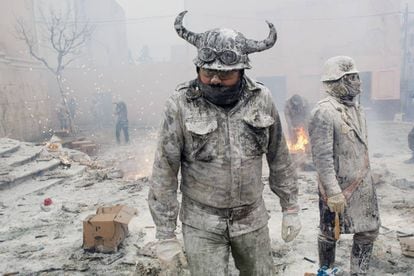Astronomical winter will begin on December 21 at 4:59 PM PST, marking the longest night of the year in the Northern Hemisphere (and the longest day of the year in the Southern Hemisphere).
For a few days before and after the solstice, the path of the Sun across the sky seems to stop;
hence the name of this astronomical phenomenon (from the Latin
solstitium
derived from sun and
sistere
"to remain still"), something that occurs because the Earth rotates tilting on its axis like a spinning top at an angle that determines how much light each region of the planet receives in a moment of its orbit.
The new season will last 88 days and will end on March 20, 2022 with the beginning of spring.
Mongolian shamans at a solstice-related ceremony.Kevin Frayer (Getty)
Lust for light
Since time immemorial, the solstices have been associated with solar cults and fertility rites.
The dances at the bonfires express the longed-for return of the sun.
And behind the street lights, the Christmas candles or the Jewish Hanukkah hide ancient spells to invoke the light.
The Romans celebrated the winter solstice - and its implicit promise of rebirth: the moment in which the shorter and shorter days lengthen again - with Saturnalia, which was celebrated between December 17 and 24 with large banquets, costumes and gift exchange, and where social roles were reversed: masters served slaves and slaves served masters.
Els Enfarinats Festival in Ibi (Alicante), on December 28, inspired by the Saturnalia of ancient Rome. Pablo Blazquez Dominguez;
Winter masquerades
In Spain, the hunger for light is reflected in the winter masquerades, such as those held on December 26 in various towns in the province of Zamora, with grotesque characters such as Zangarrón de Sanzoles, Filandorra de Ferreras de Arriba or Tafarrón from Pozuelo de Tábara;
Festivities such as Els Enfarinats de Ibi (Alicante), on December 28, inspired by the Saturnalia of ancient Rome, or the Guirria de Beleño, every January 1 in the Asturian council of Ponga.
Aerial view of Stonehenge covered by snow.Chris Gorman (Getty)
Fairies and druids
The winter solstice also acts as a magnet for the enlightened,
Newagers
, Neo-Hippies, Druids and the curious, who often flock to the megalithic circle of Stonehenge, the mysterious ring of stone monoliths that stands on the Salisbury Plain, south of England (about 150 kilometers from central London).
Built between the late Neolithic and early Bronze Age, some 5,000 years ago, its structures are aligned to mark the sunrise and sunset during the winter and summer solstices, thus signaling the beginning of the sowing time and of the harvest.
Sonehenge will open the morning of December 22 with strict anti-covid measures.
Newgrange burial mound, Ireland Ita Pentony (Getty)
The magic of the sun is repeated in other megalithic monuments, such as the awe-inspiring burial mound of Newgrange, in Ireland, 500 years before the pyramids of Egypt, where the rays of the rising sun flood the burial chamber with light for 17 minutes, or the chromlech or Castlerigg stone circle, in Keswick (England), with the beautiful hills of Cumbria as a backdrop.
On December 21, the sun penetrates the gloomy interior of the
tholos
(circular underground chamber) of El Romeral, one of the three megaliths of the Antequera (Malaga) dolmens archaeological site.
This magical phenomenon is repeated in the neighboring Menga dolmen during the summer solstice, when its orientation towards the northeast (facing the Peña de los Enamorados) causes the sun's rays to reach the slabs on its right side at dawn.
Winter solstice at the Karnak temple in Luxor (Egypt).
Land of pharaohs
The sun rises behind the Karnak temple in Luxor during the winter solstice sunrise alignment with the Great Avenue of the Sphinxes, which connects the Karnak temple, consecrated to the sun god Amun-Ra, with that of Luxor.
And on the west bank of the Nile, the Colossi of Memnon, two gigantic stone statues representing Pharaoh Amenhotep III located on the west bank of the Nile, are perfectly aligned with the sun rise.

